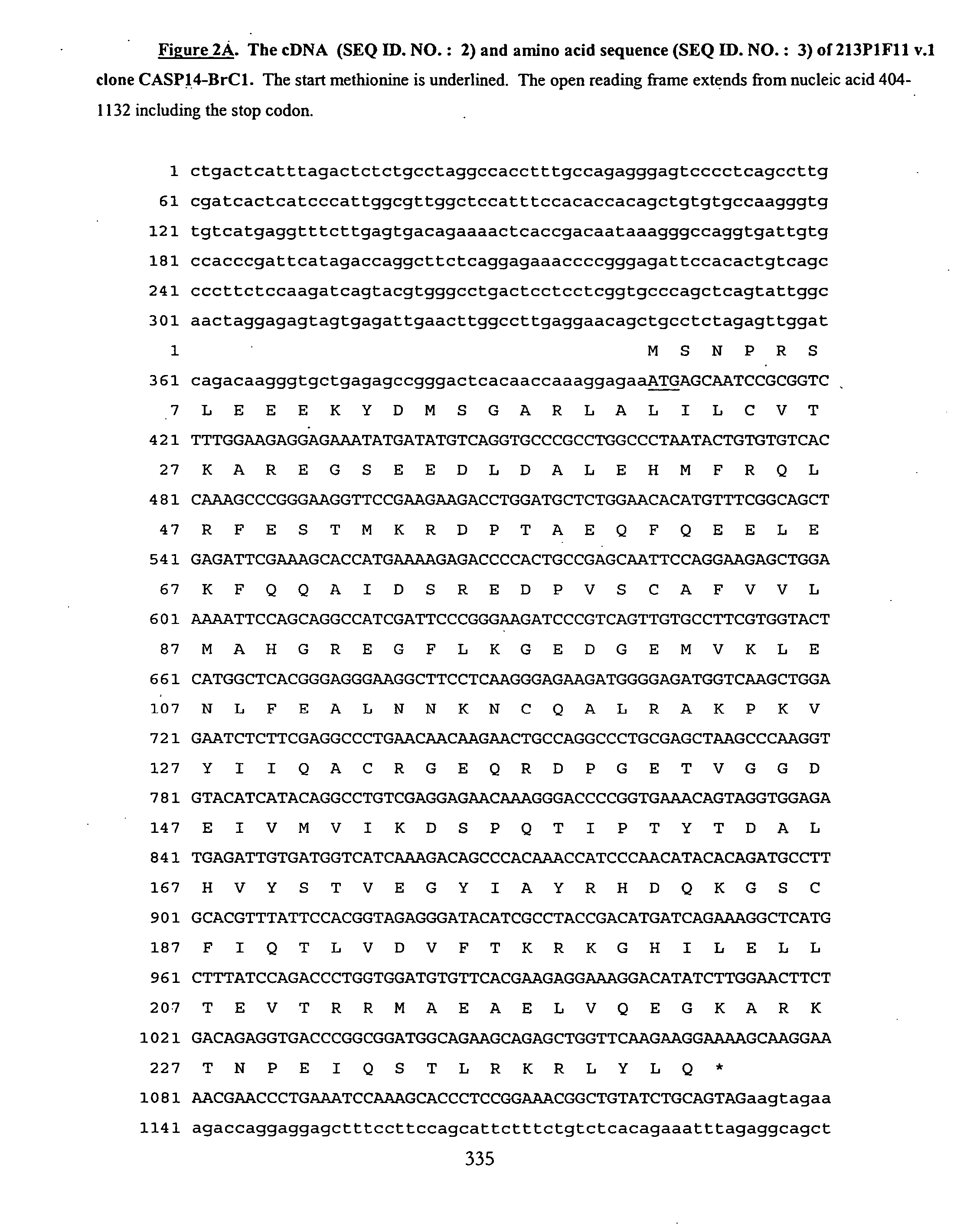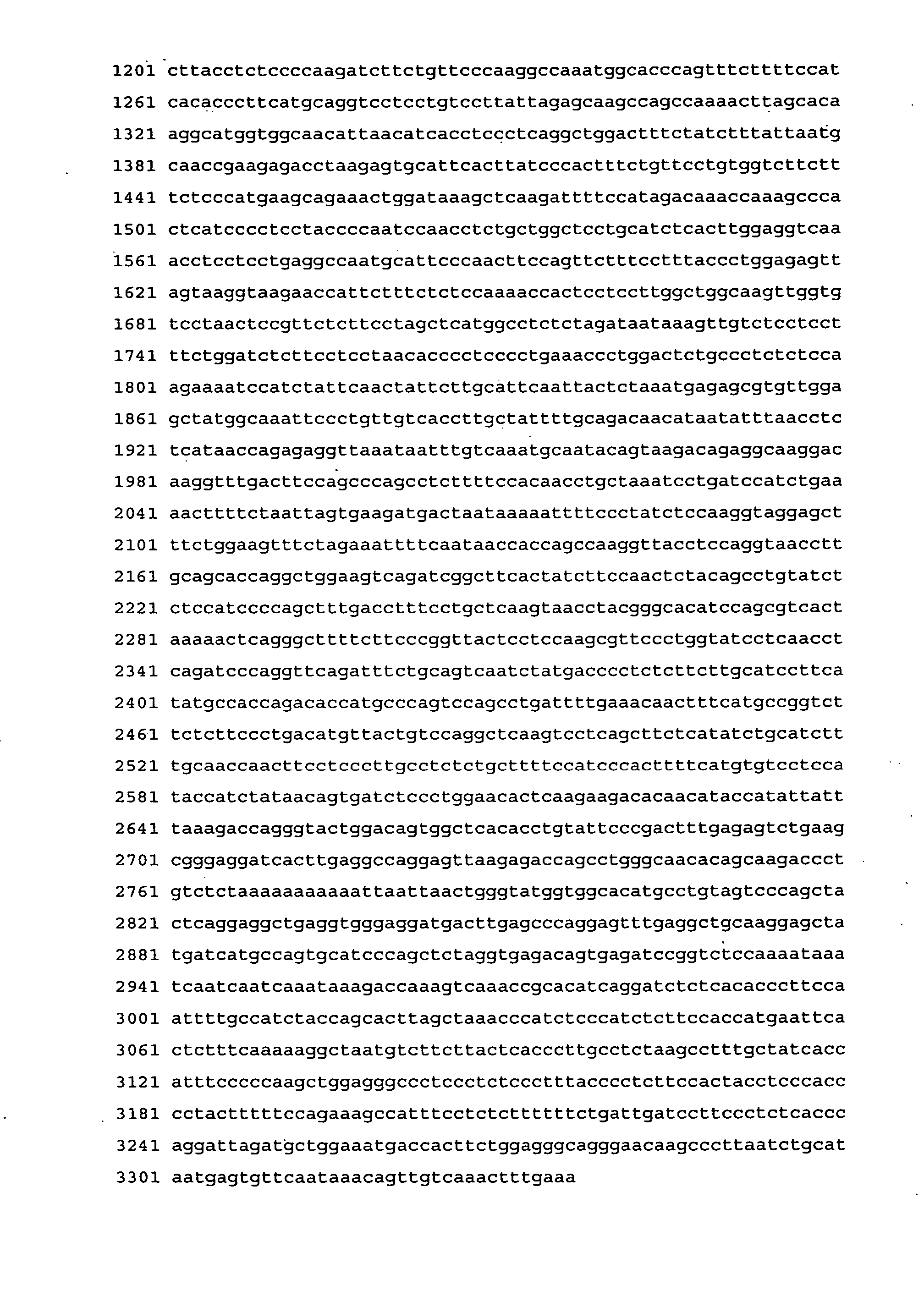Nucleic acid and corresponding protein entitled 213P1F11 useful in treatment and detection of cancer
a technology of nucleic acid and corresponding protein, which is applied in the direction of fused cells, peptide/protein ingredients, antibody medical ingredients, etc., can solve the problems of ineffective treatment for many, ineffective treatment, undesirable consequences, etc., and achieve the effect of inhibiting transcription, translation, processing or function, and inhibiting production or function
- Summary
- Abstract
- Description
- Claims
- Application Information
AI Technical Summary
Benefits of technology
Problems solved by technology
Method used
Image
Examples
example 1
SSH-Generated Isolation of a cDNA Fragment of the 213P1F11 Gene
[0420] To isolate genes that are over-expressed in bladder cancer, Suppression Subtractive Hybridization (SSH) procedure using cDNA derived from bladder cancer tissues was performed, including invasive transitional cell carcinoma. The 213P1F11 SSH cDNA sequence was derived from a bladder cancer pool minus cDNAs derived from 9 normal tissues. The 213P1F11 cDNA was identified as highly expressed in the bladder cancer tissue pool, with no expression detected in normal tissues.
[0421] The SSH DNA sequence of 166 bp (FIG. 1) did not show homology to any known gene. 213P1F11 v.1 of 3336 bp was identified and the open reading frame cloned from bladder cancer cDNA, revealing an ORF of 242 amino acids (FIG. 2 and FIG. 3). Other variants of 213P1F11, were also identified and these are listed in FIGS. 2 and 3. 213P1F11 v.1 reveals 100% identity to caspase-14 precursor apoptosis-related cysteine protease protein (FIG. 4).
[0422] Ma...
example 2
Full Length Cloning of 213P1F11
[0445] The 213P1F11 SSH cDNA sequence was derived from a bladder cancer pool minus normal tissues cDNA subtraction. The SSH cDNA sequence (FIG. 1) was designated 213P1F11.
[0446] The SSH DNA sequence of 166 bp (FIG. 1) did not show homology to any known gene. The full-length cDNA 213P1F11 was cloned from bladder cancer cDNA. Variants of 213P1F11 were identified and these are listed in FIGS. 2 and 3. 213P1F11 v.1 reveals 100% identity to caspase-14 precursor apoptosis-related cysteine protease protein (FIG. 4).
example 3
Chromosomal Mapping of 213P1F11
[0447] Chromosomal localization can implicate genes in disease pathogenesis. Several chromosome mapping approaches are available including fluorescent in situ hybridization (FISH), human / hamster radiation hybrid (RH) panels (Walter et al., 1994; Nature Genetics 7:22; Research Genetics, Huntsville Al), human-rodent somatic cell hybrid panels such as is available from the Coriell Institute (Camden, N.J.), and genomic viewers utilizing BLAST homologies to sequenced and mapped genomic clones (NCBI, Bethesda, Md.).
[0448] 213P1F11 maps to chromosome 19p13.1 using 213P1F11 sequence and the NCBI BLAST tool: located at the World Wide Web (.ncbi.nlmmih.gov / genome / seq / page.cgi?F=HsBlast.html&&ORG=Hs).
PUM
 Login to View More
Login to View More Abstract
Description
Claims
Application Information
 Login to View More
Login to View More - R&D
- Intellectual Property
- Life Sciences
- Materials
- Tech Scout
- Unparalleled Data Quality
- Higher Quality Content
- 60% Fewer Hallucinations
Browse by: Latest US Patents, China's latest patents, Technical Efficacy Thesaurus, Application Domain, Technology Topic, Popular Technical Reports.
© 2025 PatSnap. All rights reserved.Legal|Privacy policy|Modern Slavery Act Transparency Statement|Sitemap|About US| Contact US: help@patsnap.com



